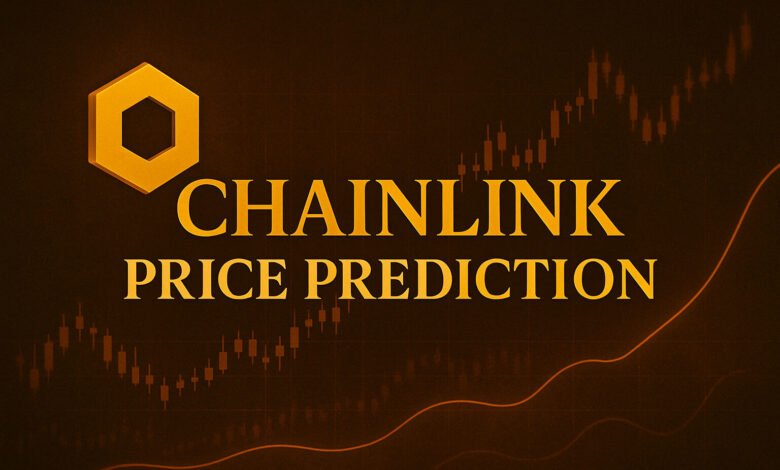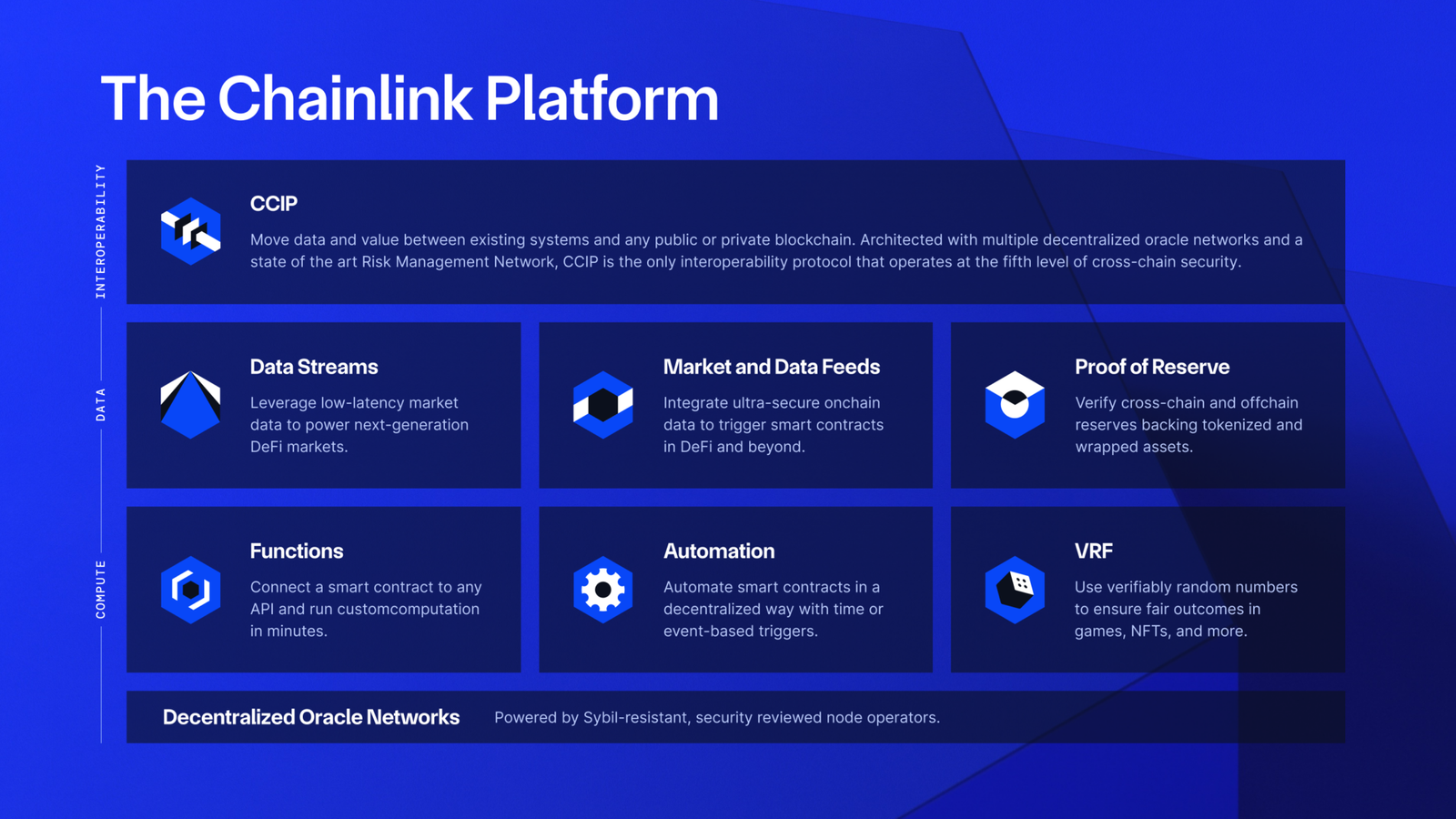Chainlink Price Prediction 2025 Oracle & BlockchainFX Analysis
Chainlink Price Prediction 2025, exploring oracle dominance, market trends, and emerging presale opportunities with BlockchainFX.

Chainlink (LINK) stands as a pioneering force in the blockchain oracle sector. As we navigate through 2025, investors and enthusiasts are increasingly curious about where LINK’s price trajectory might lead, especially as the project solidifies its position as the industry’s leading decentralized oracle network. Meanwhile, emerging platforms like BlockchainFX are introducing fresh presale opportunities that complement the established infrastructure that Chainlink has built over the years.
Understanding Chainlink Price Prediction 2025 Chainlink’s potential in 2025 requires a comprehensive examination of multiple factors: the project’s technological advancement, adoption metrics across various blockchain ecosystems, competitive positioning, and broader market dynamics. This analysis explores not only the price prediction models for LINK but also how innovative presale projects are creating new synergies within the oracle-powered blockchain economy. Whether you’re a seasoned cryptocurrency investor or someone exploring opportunities in the digital asset space, this detailed overview will provide valuable insights into what might lie ahead for Chainlink and the evolving ecosystem surrounding it.
Chainlink’s Oracle Dominance in the Blockchain Ecosystem
Chainlink has established itself as the backbone of smart contract functionality across numerous blockchain platforms. The project’s core innovation lies in solving one of the most critical challenges facing decentralized applications: the oracle problem. Smart contracts, by their nature, cannot access external data without compromising their decentralized properties. Chainlink bridges this gap by providing a decentralized network of nodes that securely transmit real-world data to blockchain-based applications.
The oracle network that Chainlink operates has become indispensable for various sectors within the cryptocurrency industry. Decentralized finance protocols rely heavily on Chainlink’s price feeds to execute lending, borrowing, and trading operations with accurate market data. Gaming platforms utilize Chainlink’s verifiable random function to ensure fairness in their applications. Insurance protocols depend on Chainlink’s ability to verify real-world events and trigger automated payouts accordingly.
Throughout 2024 and into 2025, Chainlink has expanded its technological capabilities significantly. The introduction of Chainlink 2.0 brought enhanced scalability, reduced operational costs, and improved security mechanisms. The Cross-Chain Interoperability Protocol (CCIP) has positioned Chainlink as a crucial infrastructure component for blockchain communication, enabling seamless asset and data transfers across different networks. This technological evolution has strengthened LINK’s fundamental value proposition and created multiple revenue streams for the network.
The adoption metrics tell a compelling story. Hundreds of projects across Ethereum, Binance Smart Chain, Polygon, Avalanche, and numerous other platforms have integrated Chainlink oracles. Major financial institutions have begun exploring Chainlink’s enterprise solutions, recognizing the potential for blockchain technology to transform traditional finance operations. This widespread adoption creates sustained demand for LINK tokens, which are required to pay node operators for their data provision services.
Technical Analysis and Market Sentiment for LINK in 2025
Analyzing Chainlink’s price potential requires examining both technical indicators and fundamental market sentiment. The cryptocurrency market has matured considerably, with institutional participation reaching unprecedented levels. This maturation has brought more sophisticated analytical approaches to price prediction, moving beyond pure speculation toward data-driven forecasting.
From a technical perspective, LINK has demonstrated remarkable resilience during market downturns. The token established strong support levels during previous bear markets, and these foundations have provided launching points for subsequent rallies. Chart patterns suggest that LINK follows broader market trends while occasionally outperforming during periods of heightened interest in infrastructure projects. The trading volume surrounding LINK indicates sustained interest from both retail and institutional investors.
Market sentiment analysis reveals optimistic outlooks from various cryptocurrency analysts and research firms. Conservative estimates place LINK’s potential 2025 price range between $30 and $50, assuming moderate market conditions and continued adoption growth. More bullish scenarios, contingent on widespread mainstream adoption of blockchain technology and exceptional execution of Chainlink’s roadmap, suggest possible peaks exceeding $75 to $100. These predictions factor in historical performance, technological development milestones, and comparative analysis with other infrastructure tokens.
The tokenomics of LINK also play a crucial role in price predictions. The circulating supply dynamics, staking mechanisms introduced with Chainlink 2.0, and token burn proposals all influence supply-demand equilibrium. As more LINK tokens become locked in staking contracts to secure network operations, the available circulating supply decreases, potentially creating upward price pressure if demand remains constant or increases.
External market factors will significantly impact LINK’s performance. Regulatory clarity around cryptocurrencies, Bitcoin’s price movements as the market leader, Ethereum’s ecosystem growth, and macroeconomic conditions all contribute to LINK’s price trajectory. The correlation between LINK and broader market movements has been strong historically, though Chainlink occasionally demonstrates independence during periods of significant technological announcements or partnership reveals.
BlockchainFX and the Emerging Presale Innovation Landscape
While established projects like Chainlink offer stability and proven utility, the cryptocurrency presale sector continues to attract attention from investors seeking early-entry opportunities. BlockchainFX represents the type of innovative project that aims to leverage existing infrastructure, including oracle networks, to deliver novel solutions to market participants.
Presale opportunities have historically provided substantial returns for early supporters who identify promising projects before mainstream recognition. However, this space requires careful due diligence, as not all presale projects deliver on their initial promises. The key differentiators for successful presale projects include strong technical foundations, experienced development teams, clear use cases addressing genuine market needs, and transparent communication with their communities.
BlockchainFX positions itself within the intersection of foreign exchange markets and blockchain technology, an area with enormous potential given the trillions of dollars traded in forex markets daily. The project’s concept revolves around bringing decentralized finance principles to traditional currency trading, potentially democratizing access to forex opportunities that have historically been dominated by institutional players. Integration with Oracle networks like Chainlink would be essential for such projects to function reliably, as accurate real-time price data forms the foundation of any trading platform.
The presale innovation space has evolved considerably from the initial coin offering frenzy of previous years. Modern presales typically feature more structured approaches with vesting schedules, anti-whale mechanisms to prevent excessive concentration of tokens, and clearer regulatory compliance frameworks. Projects that succeed in building genuine utility and fostering engaged communities often transition successfully from presale stages to mainstream exchanges and sustained market presence.
For investors evaluating opportunities like BlockchainFX alongside established holdings such as Chainlink, portfolio diversification strategies become paramount. Balancing exposure between proven infrastructure projects and higher-risk, higher-potential-reward presale opportunities can optimize risk-adjusted returns. The synergy between these categories exists in how emerging projects depend on the infrastructure that pioneers like Chainlink have established.
Strategic Investment Considerations for 2025
Navigating the cryptocurrency investment landscape in 2025 requires a nuanced understanding of various factors that extend beyond simple price predictions. The relationship between infrastructure tokens like LINK and emerging presale opportunities creates a diversified approach that many sophisticated investors are adopting.
Risk management remains the cornerstone of successful cryptocurrency investing. While Chainlink offers relative stability through its established market position and proven utility, presale projects carry inherently higher risk profiles due to their early-stage nature. Allocating capital proportionally based on risk tolerance helps investors participate in potential growth while protecting against downside scenarios. A common strategy involves maintaining core positions in established projects while dedicating smaller percentages to speculative presale opportunities.
The importance of fundamental analysis cannot be overstated. For Chainlink, evaluating the continuous expansion of partnership networks, technological roadmap execution, and competitive positioning against emerging oracle solutions provides insight into long-term viability. The project’s ability to maintain its first-mover advantage while innovating against competitors like Band Protocol and API3 will significantly influence its price performance throughout 2025 and beyond.
Timing considerations also factor prominently into investment decisions. Dollar-cost averaging strategies, where investors make regular purchases regardless of price fluctuations, help mitigate the impact of volatility inherent in cryptocurrency markets. This approach proves particularly effective for assets like LINK that have demonstrated long-term upward trajectories despite short-term fluctuations. For presale opportunities, early participation often provides favorable token prices, though careful evaluation of project legitimacy takes precedence over merely securing low entry points.
The regulatory environment continues evolving globally, with different jurisdictions taking varying approaches to cryptocurrency oversight. Staying informed about regulatory developments helps investors anticipate potential market impacts. Projects with strong compliance frameworks and transparent operations typically navigate regulatory challenges more successfully, making these factors important evaluation criteria alongside technological merits.
Technology and Financial Innovation: Chainlink Price Prediction 2025
The broader narrative surrounding Chainlink’s 2025 outlook extends beyond isolated price predictions to encompass the transformative potential of oracle technology across multiple industries. As blockchain adoption accelerates in enterprise environments, the demand for reliable, decentralized data feeds grows proportionally. Chainlink’s positioning at this intersection creates long-term value that transcends short-term price movements.
Financial innovation powered by Oracle networks is enabling previously impossible applications. Parametric insurance products that automatically pay claims based on verifiable events, decentralized prediction markets that settle based on real-world outcomes, and cross-chain decentralized exchanges that access liquidity across multiple networks all depend on oracle infrastructure. As these applications mature and gain mainstream adoption, the tokens powering underlying infrastructure networks benefit from increased utility and demand.
The tokenization of real-world assets represents another frontier where oracle technology proves essential. As physical assets ranging from real estate to commodities transition onto blockchain platforms, accurate price feeds and verification mechanisms become critical. Chainlink’s expansion into providing off-chain computation through Chainlink Functions and facilitating cross-chain communication positions the network as fundamental infrastructure for this emerging asset class.
Enterprise adoption patterns suggest growing recognition of blockchain technology’s potential to streamline operations and reduce costs. Major corporations experimenting with blockchain solutions frequently encounter the need for reliable external data, creating a natural demand for oracle services. Chainlink’s CCIP and enterprise-focused offerings position the project to capture significant market share as traditional industries increasingly integrate blockchain technology into their operations.
The synergy between established infrastructure projects and emerging innovations creates a virtuous cycle benefiting the entire ecosystem. As platforms like BlockchainFX and similar projects build on foundations established by Chainlink, they create additional demand for oracle services while expanding the overall addressable market for blockchain applications. This ecosystem growth contributes to network effects that strengthen the value proposition of foundational infrastructure projects.
Conclusion
Chainlink’s price trajectory in 2025 appears promising based on multiple converging factors: technological advancement through Chainlink 2.0 and CCIP, sustained adoption across diverse blockchain ecosystems, growing enterprise interest, and the overall maturation of cryptocurrency markets. While precise price predictions remain speculative by nature, the fundamental strength of Chainlink’s oracle network suggests continued growth potential. Conservative estimates place LINK within a $30-$50 range, with bullish scenarios extending significantly higher depending on market conditions and adoption acceleration.
The emergence of presale opportunities like BlockchainFX adds an interesting dimension to the cryptocurrency investment landscape, offering higher-risk, potentially higher-reward options that complement core holdings in established projects. The key to navigating 2025 successfully lies in balanced portfolio construction, thorough due diligence, and maintaining focus on fundamental value creation rather than pure speculation.
As blockchain technology continues its journey toward mainstream adoption, infrastructure projects like Chainlink will likely maintain their critical importance. The oracle problem that Chainlink solved remains fundamental to smart contract functionality, ensuring sustained relevance regardless of which specific blockchain platforms ultimately dominate. For investors willing to embrace the volatility inherent in cryptocurrency markets while focusing on projects with genuine utility and strong execution track records, 2025 presents compelling opportunities across both established and emerging segments of the digital asset ecosystem.
FAQs
Q: What factors most significantly influence Chainlink’s price in 2025?
Chainlink’s price is influenced by multiple interconnected factors, including the overall cryptocurrency market sentiment, Bitcoin’s performance as the market leader, adoption rates of Chainlink’s oracle services across blockchain platforms, technological developments like CCIP implementation, competitive positioning against alternative oracle solutions, regulatory developments affecting the broader crypto industry, and macroeconomic conditions influencing risk asset allocation. The token’s utility in powering the oracle network creates fundamental demand that supports long-term value, while market dynamics drive short-term price fluctuations.
Q: How does Chainlink’s oracle technology provide value to the blockchain ecosystem?
Chainlink solves the oracle problem by providing decentralized mechanisms for smart contracts to access external data without compromising security or decentralization. This capability is fundamental for DeFi protocols requiring accurate price feeds, gaming applications needing verifiable randomness, insurance products triggering based on real-world events, and countless other applications. The oracle network creates value by enabling smart contracts to interact with data sources beyond their native blockchains, dramatically expanding the potential use cases for blockchain technology across industries.
Q: Are presale projects like BlockchainFX suitable for all investors?
Presale projects carry significantly higher risk profiles than established cryptocurrencies due to their early-stage nature, lack of proven track records, and potential for project failure. They are generally more suitable for investors with higher risk tolerance, adequate capital to absorb potential losses, and the expertise to conduct thorough due diligence. Conservative investors should maintain core portfolio positions in established projects while allocating only small percentages to speculative presale opportunities. Understanding project fundamentals, team credentials, tokenomics, and use case viability is essential before participating in any presale.
Q: What role does Chainlink’s CCIP play in its future growth potential?
The Cross-Chain Interoperability Protocol represents a significant expansion of Chainlink’s addressable market beyond traditional oracle services. CCIP enables secure communication and asset transfers between different blockchain networks, addressing one of the industry’s most pressing challenges. As the blockchain ecosystem becomes increasingly multi-chain rather than dominated by single platforms, interoperability solutions become critical infrastructure. CCIP positions Chainlink to capture value from this trend while creating additional use cases for LINK tokens, potentially driving both adoption and price appreciation.
Q: How should investors balance holdings between established projects like Chainlink and emerging presale opportunities?
Portfolio allocation should reflect individual risk tolerance, investment timeline, and financial goals. A common approach involves maintaining 60-80% of cryptocurrency holdings in established projects with proven utility and market presence, while allocating 10-20% to emerging opportunities offering higher growth potential but greater risk. The remaining portion might be held in stablecoins or Bitcoin for liquidity and stability. Within the high-risk allocation, diversification across multiple presale projects rather than concentration in a single opportunity helps manage risk. Regular portfolio rebalancing based on performance and changing market conditions maintains desired risk exposure levels.


